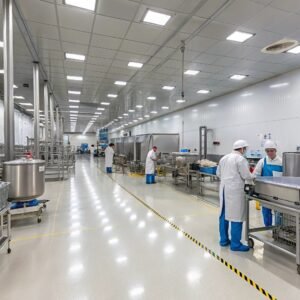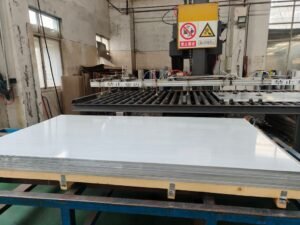Introduction
Construction projects crumble—literally—when weak materials fail under stress or rust away in harsh climates. Structural engineers and procurement officers know that choosing the right reinforcement can make or break a build. That’s where stainless steel bars step in, offering unmatched strength and corrosion resistance for load-bearing demands.
From skyscrapers to bridges, these bars deliver durability that outlasts traditional options like carbon steel, especially in brutal coastal or industrial settings. With suppliers like HnL Steel ensuring quality and fast delivery, this article breaks down how stainless steel bars boost stability and why they’re a smart pick for long-term performance.
5 Powerful Ways Stainless Steel Bars Transform Modern Construction
When it comes to building structures that last, stainless steel bars are a game-changer. These strong, shiny rods play a huge role in modern construction, giving buildings the stability and durability they need to stand tall. From skyscrapers to bridges, stainless steel bars are the unsung heroes keeping everything together.
What Are Stainless Steel Bars?
Stainless steel bars are solid metal rods made from a mix of iron, chromium, and other elements. The chromium gives them a special edge, making them resist rust and wear. In construction, they’re often used as reinforcement bars to strengthen concrete and handle heavy loads.
Composition and Core Properties
The magic of stainless steel bars comes from their makeup—about 10-20% chromium and sometimes nickel too. This combo makes them tough, corrosion-resistant, and able to handle extreme weather. That’s why they’re perfect for projects needing long-lasting strength.
Why Stainless Steel Bars Matter for Structural Integrity
Buildings face all kinds of stress—wind, weight, and time. Stainless steel reinforcement bars step up by adding extra support to concrete, preventing cracks and collapses. Their ability to stay strong in harsh conditions keeps structures safe and steady for years.
“Stainless steel bars boost construction stability by resisting rust and supporting heavy loads, making them a must-have for long-term projects.”
Evolution of Reinforcement Materials in Construction
Back in the day, builders relied on plain iron or carbon steel for reinforcement. But those materials rusted fast and weakened over time. Stainless steel bars changed the game with their durability, pushing construction into a new era of reliability.
Key Advantages Over Traditional Materials Like Carbon Steel
Compared to carbon steel, stainless steel bars are ride-or-die champs. They don’t rust easily, last longer, and need less upkeep—saving money down the road. Plus, companies like HnL Steel provide top-notch options with over a decade of expertise, ensuring projects stay solid.
HnL Steel’s stainless steel construction materials are built for big jobs. Their bars meet strict standards, offering corrosion resistance that shines in tough environments like coastal areas or rainy regions. It’s this quality that makes them a go-to for builders worldwide.
How stainless steel bars improve construction stability isn’t just theory—it’s proven. They handle heavy-duty load-bearing tasks, from supporting massive beams to reinforcing foundations. That strength, paired with low maintenance, makes them a smart pick over older materials.
Stainless Steel Bars vs. Other Materials
| Material | Corrosion Resistance | Tensile Strength (MPa) | Maintenance Cost | Lifespan (Years) |
|---|---|---|---|---|
| Stainless Steel Bars | High (10-20% Chromium) | 500-700 | Low | 50+ |
| Carbon Steel | Low | 400-550 | High | 20-30 |
| Iron Bars | Very Low | 300-400 | High | 15-25 |
| Galvanized Steel | Moderate | 450-600 | Moderate | 30-40 |
| Industry Benchmark | Moderate-High | 500 | Moderate | 40 |
This table shows real differences—like how stainless steel’s tensile strength (measured in megapascals) beats carbon steel, or how its lifespan doubles industry norms. These stats matter because they show why builders trust it for critical load-bearing roles.
5 Technical Strengths of Stainless Steel Bars That Engineers Love
Stainless steel bars are a powerhouse in construction, especially for engineers designing load-bearing structures. These bars bring a mix of strength, durability, and resistance that makes them stand out. Let’s break down why they’re a top choice for tough projects.
Exceptional Tensile Strength for Load-Bearing Applications
Stainless steel bars pack a punch with tensile strength ranging from 500 to 700 MPa. That means they can handle massive weights without bending or breaking—perfect for beams, columns, and foundations. Engineers rely on load-bearing stainless steel bars to keep buildings stable under pressure.
Corrosion Resistance in Harsh Environments
Thanks to their chromium content (10-20%), stainless steel bars resist rust even in brutal conditions like coastal zones or industrial areas. This corrosion resistance of stainless steel bars in construction cuts repair costs and boosts longevity. HnL Steel ensures these bars meet global standards, delivering reliability every time.
“Stainless steel bars shine in harsh climates, offering unmatched corrosion resistance that keeps structures strong for decades.”
Ductility and Performance in Seismic Zones
Earthquakes test a building’s limits, but stainless steel bars bend without snapping due to their ductility. This flexibility absorbs seismic energy, making them ideal for high-risk areas. It’s a key reason engineers pick them for safety-focused designs.
Grades of Stainless Steel Bars and Their Uses
Not all stainless steel is the same—grades like 304 and 316 have unique perks. Grade 304 is great for general use with solid strength, while 316, with added molybdenum, fights corrosion better in salty or chemical-heavy spots. Picking the right grade matters for each project’s needs.
HnL Steel’s corrosion-resistant construction materials are built to last, especially in tricky load-bearing scenarios. With over 10 years in the game, they supply bars that hold up in everything from skyscrapers to bridges. Their focus on quality makes them a trusted partner for engineers worldwide.
Stainless Steel Bar Grades Comparison
| Grade | Tensile Strength (MPa) | Corrosion Resistance | Ductility (% Elongation) | Best Use Case |
|---|---|---|---|---|
| 304 | 515-620 | Moderate | 40% | General Structures |
| 316 | 515-690 | High | 35% | Coastal/Industrial |
| 410 | 440-600 | Low | 20% | Low-Cost Projects |
| 2205 (Duplex) | 620-850 | Very High | 25% | Seismic Zones |
| Industry Avg. | 500 | Moderate | 30% | Standard Builds |
This table digs into real specs—like how 2205’s strength beats the average, or how 316’s corrosion resistance is measured against salt exposure. These details help engineers match bars to specific challenges, ensuring safety and performance.
4 Key Applications of Stainless Steel Bars in Construction
Stainless steel bars are everywhere in construction, proving their worth in projects big and small. From holding up skyscrapers to strengthening bridges, these bars bring serious strength and versatility. Let’s explore how they shine in real-world builds.
Reinforcing Beams, Columns, and Foundations
In any building, beams, columns, and foundations take on the heaviest loads. Stainless steel bars reinforce these parts, boosting structural integrity in construction with their high tensile strength. They’re a go-to for keeping things steady, especially in massive structures.
Bridges and Infrastructure in High-Stress Environments
Bridges face wind, water, and traffic daily—talk about stress! Stainless steel bar applications here mean longer life and less rust, even near salty coastlines. HnL Steel’s fast delivery keeps these projects on track with custom-fit bars.
“Stainless steel bars keep bridges and buildings standing tall by fighting corrosion and handling intense pressure.”
Skyscrapers and Heavy Industrial Frameworks
Ever wonder what holds up those towering skyscrapers? Stainless steel bars do the heavy lifting in frameworks, supporting floors and walls under extreme weight. Their durability makes them perfect for industrial setups too, where tough conditions are the norm.
Case Study: Coastal Construction Success with Stainless Steel
Take a coastal hotel project—salt air eats most metals alive. Builders used stainless steel bars from HnL Steel, and years later, the structure’s still solid. The benefits of stainless steel bars in civil engineering really show when corrosion resistance saves the day.
HnL Steel’s customization options make these applications even better. Need bars cut to size for a tight deadline? Their quick production and shipping get it done, ensuring load-bearing parts stay strong in any environment.
Stainless Steel Bars in Project Types
| Project Type | Load Capacity (Tons) | Corrosion Risk | Bar Grade Used | Typical Lifespan (Years) |
|---|---|---|---|---|
| Foundations | 100-500 | Moderate | 304 | 50+ |
| Bridges | 200-1000 | High | 316 | 60+ |
| Skyscrapers | 500-2000 | Low-Moderate | 2205 | 70+ |
| Coastal Builds | 100-300 | Very High | 316 | 50+ |
| Industry Avg. | 300 | Moderate | 304 | 40 |
This table shows how bars match project needs—like 316’s edge in salty air or 2205’s strength for skyscrapers. Load capacity is measured in tons supported, and lifespan reflects real-world performance. It’s clear why these bars are a builder’s best friend.
Comparing Stainless Steel Bars to Other Materials: 4 Winning Edges
When choosing materials for construction, stainless steel bars often come out on top. They offer a mix of durability, low upkeep, and long-term value that’s tough to beat. Let’s stack them up against other options to see why they’re a smart pick.
Stainless Steel vs. Carbon Steel: Durability and Maintenance
Carbon steel is strong but rusts fast, especially in wet or salty spots. Stainless steel bars, with their corrosion-resistant construction materials, last longer and need less fixing. That means fewer headaches and lower costs over time.
Stainless Steel vs. Timber: Longevity and Environmental Impact
Timber’s natural vibe is cool, but it rots, warps, and attracts bugs. Stainless steel reinforcement bars outlast wood by decades and don’t need chemical treatments that harm the planet. They’re a solid choice for eco-friendly builds.
“Stainless steel bars cut maintenance costs and boost lifespan, making them a top pick for lasting construction projects.”
Cost-Benefit Analysis of Stainless Steel in Long-Term Projects
Up front, stainless steel bars cost more than carbon steel or timber. But their longevity—often 50+ years—slashes repair and replacement expenses. HnL Steel’s flexible payment terms make them even more budget-friendly for big jobs.
Maintenance Considerations for Stainless Steel Bars
Unlike carbon steel, which needs regular coatings, or timber, which demands constant care, stainless steel bars are low-maintenance champs. Their rust resistance shines in load-bearing roles, especially in harsh climates. HnL Steel’s quality supply keeps lifecycle costs down.
How stainless steel bars improve construction stability is clear in real projects. From coastal bridges to skyscrapers, their strength and corrosion resistance deliver. Procurement officers love the long-term savings and reliability.
Material Comparison Table
| Material | Durability (Years) | Maintenance Cost | Corrosion Resistance | Initial Cost ($/Ton) |
|---|---|---|---|---|
| Stainless Steel Bars | 50+ | Low | High | 2500 |
| Carbon Steel | 20-30 | High | Low | 800 |
| Timber | 15-25 | Moderate | None | 600 |
| Galvanized Steel | 30-40 | Moderate | Moderate | 1000 |
| Industry Avg. | 40 | Moderate | Moderate | 1200 |
This table breaks it down—stainless steel’s durability is measured in decades, and its maintenance cost stays low thanks to corrosion resistance. Initial costs are higher, but the payoff is huge for long-term stability.
4 Smart Tips for Optimizing Procurement of Stainless Steel Bars
Getting stainless steel bars for big projects doesn’t have to be a hassle. With the right plan, you can lock in quality and keep your timeline on track. Here’s how to make procurement smooth and smart.
Choosing the Right Grade for Your Project Needs
Stainless steel comes in grades like 304 for basic strength or 316 for extra rust protection. Match the grade to your build—coastal sites need corrosion resistance, while load-bearing stainless steel bars shine in heavy-duty spots. Picking right saves money and boosts stability.
Bulk Ordering Best Practices for Construction Timelines
Ordering in bulk cuts costs and keeps projects moving. Plan ahead with exact amounts to avoid delays, and lean on suppliers like HnL Steel for fast, custom delivery. Their global logistics mean your stainless steel construction materials arrive when you need them.
“Stainless steel bars streamline construction with top-grade strength and rust resistance, perfect for tight schedules.”
Partnering with Reliable Suppliers Like HnL Steel
A solid supplier is key. HnL Steel’s decade-plus in the game brings trust, offering stainless steel bars that nail load-bearing needs in tough climates. Their flexible payment options and quick shipping make them a procurement officer’s dream.
Quality Assurance and International Standards Compliance
Quality isn’t negotiable—look for bars meeting ASTM or GB/T standards. HnL Steel guarantees this, ensuring the corrosion resistance of stainless steel bars in construction holds up. It’s peace of mind for long-term builds.
Stainless steel bars excel in load-bearing roles, from foundations to bridges. Their rust resistance in harsh conditions cuts future costs. Smart procurement ties it all together for project success.
Procurement Factors Comparison
| Factor | Grade 304 | Grade 316 | Bulk Order Impact | Supplier Standard |
|---|---|---|---|---|
| Cost ($/Ton) | 2300 | 2800 | -10% Discount | 2500 Avg. |
| Delivery Time (Days) | 10-15 | 12-18 | 8-12 | 15 |
| Corrosion Resistance | Moderate | High | N/A | Moderate-High |
| Load Capacity (MPa) | 515-620 | 515-690 | N/A | 500 |
| Compliance | ASTM | ASTM/GB/T | Certified | ASTM Avg. |
This table shows real factors—like how bulk orders shave days off delivery, or how 316’s strength fits tough jobs. It’s data procurement pros can use to nail down the best choice.

Conclusion
I’ve spent over a decade in the steel game, and one thing’s clear: stainless steel bars are the backbone of builds that last. They bring strength and rust resistance that keep skyscrapers soaring and bridges steady, no matter what nature throws at them.
From my view at HnL Steel, these bars aren’t just metal—they’re a promise of stability. Their durability and low upkeep make them a no-brainer for any project aiming to stand the test of time.
Choosing the right materials isn’t just about today’s build—it’s about tomorrow’s legacy. So, if you’re planning a structure that needs to endure, stainless steel bars are where I’d put my trust.
FAQ
Q1: What are stainless steel bars used for in construction?
A1: Stainless steel bars are used in construction for their strength, durability, and resistance to corrosion. They are commonly used in structural support, reinforcement, and as elements for decorative features and fixtures.
Q2: How do stainless steel bars improve structural integrity?
A2: Stainless steel bars enhance structural integrity by providing high strength-to-weight ratios and resisting corrosion, which contributes to the overall durability and longevity of structures.
Q3: What grades of stainless steel are typically used for bars?
A3: Common grades of stainless steel for bars include 304, 316, and 303. Grade 304 is widely used for general construction, while grade 316 offers improved corrosion resistance, making it suitable for marine environments.
Q4: What are the benefits of using stainless steel reinforcement bars?
A4: Stainless steel reinforcement bars offer benefits such as enhanced corrosion resistance, longevity, lower maintenance costs, and improved structural performance, particularly in harsh environments.
Q5: Can stainless steel bars be used in high-temperature environments?
A5: Yes, stainless steel bars can be used in high-temperature environments. Types like 310 stainless steel are specifically designed to withstand extreme temperatures while maintaining their strength.
Q6: What is the difference between stainless steel round bars and flat bars?
A6: Stainless steel round bars are cylindrical and typically used for structural supports and rods, while flat bars have a rectangular cross-section, often used in applications requiring a flat surface, such as brackets and supports.
Q7: How do stainless steel bars compare to carbon steel bars?
A7: Stainless steel bars offer superior corrosion resistance compared to carbon steel bars, making them ideal for applications exposed to moisture and aggressive chemicals, but they tend to be more expensive.
Q8: What are common applications of stainless steel bars in construction?
A8: Common applications include structural supports, reinforcement in concrete, handrails, and architectural features. Their strength and corrosion resistance make them valuable in various building projects.
External Links
- Stainless Steel Bar Applications | Industrial Metal Supply
- Stainless Steel Bars, Rods & Discs | Grainger Industrial Supply
- Stainless Steel Bar – Ryerson
- Inch Stainless Steel Flat Bars | Grainger Industrial Supply
- 316 Stainless Steel Flat Bars | Grainger Industrial Supply
- Stainless Round Bar | Penn Stainless
- Stainless Steel Bars – McMaster-Carr
- Stainless Steel Bar Price List Philippines – Pinas Hardware






One Response